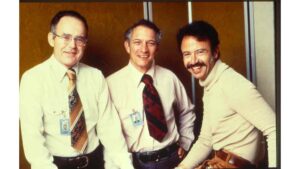The Gordon and Betty Moore Foundation has announced that its founder, Gordon Moore, passed away on March 24 at the age of 94.
Moore leaves behind a legacy of world-changing innovations, entrepreneurship and philanthropy. The Foundation has donated more than $5.1 billion US to charitable causes since its establishment in 2000.
“Gordon Moore was an inspirational figure who changed the world through dedication to scientific inquiry and philanthropy. The Moore Foundation continues to create positive outcomes for society by supporting high-impact research and development programs aimed at solving the world’s biggest challenges,” said Blusson QMI Scientific Director Prof. Andrea Damascelli. “At Blusson QMI, we’re honored to be a part of a number of such projects supported by the Foundation.”

Image: An undated photo shows Gordon Moore (from left), Robert Noyce and Andy Grove. Moore and Noyce were co-founders of Intel Corporation in July 1968 (Credit: Intel Corporation).
Blusson QMI is home to UBC-Moore Centre for Ultrafast Quantum Matter, which was established in 2015 thanks to a $1.4 million US grant from the Foundation. The Centre was the first project supported by the Foundation outside of the U.S.
Led by Damascelli and David Jones, the Centre combines a novel tunable extreme-ultra-violet laser source with an unprecedented combination of high photon energy, brightness, repetition rate, narrow pulse width, and energy resolution with time and angle-resolved photoemission spectroscopy.
“With the Foundation’s support, we have established two integrated state-of-the-art capabilities at UBC that enable a wide range of experiments that condensed matter physicists around the world have yearned to perform for years,” said Damascelli.
In 2021, the Foundation funded and established several Summer Research Fellowships for students from underrepresented groups to conduct research at the MP-UBC-UTokyo Centre for Quantum Materials (CQM). The fellowships covered student travel and direct research expenses.
In 2022, the Foundation invested in a unique research project by Blusson QMI scholars titled High-Temperature Topological Superconductivity in Twisted Cuprates. The experimental effort, led by early career researcher Zilliang Ye with participation from Douglas Bonn, Sarah Burke, Andrea Damascelli, and Marcel Franz, has the potential to establish the first genuine high-temperature topological superconductor, which in turn could help lay the foundation for future quantum technologies.
In 1996, Moore and his longtime colleague Robert Noyce founded Intel. Moore initially served as executive vice president until 1975, when he became president. In 1979, Moore was named chairman of the board and chief executive officer, posts he held until 1987, when he gave up the CEO position and continued as chairman. In 1997, Moore became chairman emeritus, stepping down in 2006.
Moore’s also known for a prediction he made in a 1965 magazine article that later came to be known as Moore’s Law. He had predicted that the number of transistors on an integrated circuit would double every year.
After retiring from Intel in 2006, Moore served as chairman of the board for the Foundation until transitioning to chairman emeritus in 2018. Moore also served as a member of the board of directors of Conservation International and Gilead Sciences, Inc.
Moore received the National Medal of Technology in 1990, and the Presidential Medal of Freedom, the highest civilian honor in the U.S., in 2002. He was a member of the National Academy of Engineering, a Fellow of the Royal Society of Engineers, and a Fellow of the Institute of Electrical and Electronics Engineers.
He is survived by his wife of 73 years, Betty, sons Kenneth and Steven, and four grandchildren.
Banner image: Walden Kirsch/Intel Corporation.


